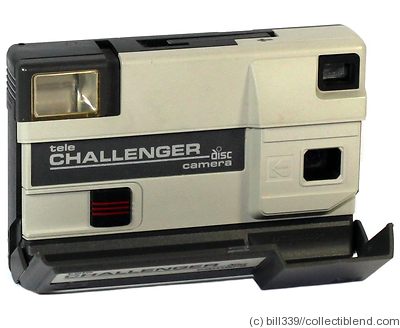Don't forget to update your personal camera inventory
Kodak Eastman: Challenger
CollectiBlend Average Index
We don't have enough information to provide an accurate price for this camera, so this is the suggestion based on what we have. | ||||||||||||
| Camera rarity | ||||||||||||
Searching eBay listings: 
1986-1990. VR disk camera.

Camera featured in these collections: bill339![]() JPetri
JPetri
Camera is in these wishlists: AustinAlbright
converted and inflation-adjusted prices:
| Condition | Price | |||
| 2003-02-28 | $16 | |||
Post a reply
The Kodak Tele Disc was introduced in the middle of the short-lived disc camera era in order to spice up Kodak’s lineup. Interestingly, the Tele Disc has two lens choices: a normal 12.5mm f/4 and 22mm f/5.6 telephoto. Unlike the Ricoh R1 which relies on the insertion of additional optical elements to modify the focal length, the Tele Disc actually has two separate lenses. Extending the flash rotates the telephoto lens into place and also swaps in a new viewfinder. The Kodak Challenger was introduced in 1986 and discontinued in 1990 at the end of the disc era that started in 1982 and ended in 1998 with the discontinuation of production of the film by Kodak. Kodak’s inventory of disc film ran out in 1999. The Challenger is a 'premium' version of the Disc 3600 and not as easy to find as one might anticipate. The shutter speed is 1/300 of a second and the camera used the VR Disc that gave you an 8 by 10mm picture size. The camera also has a carry strap, flash off slide switch, frame count window, flash ready light, built in lens cover, power film advance, and it uses two AA batteries to power it all.
A disc film cartridge is a bit smaller than a 3.5 inch floppy disk and behaves much like the disk for a View-Master. Pressing the red-striped shutter button exposes an 8x11mm frame on the disk, which then rotates 24° for the next photo for a total of 15 frames per cartridge. Despite the convenience and foolproof loading procedure, disc film was a big commercial failure. Although new emulsion technology at the time meant that the tiny negatives contained a relatively surprising amount of detail, graininess, and poor image quality disappointed consumers and led to disc film’s ultimately forgettable demise.
A disc film cartridge is a bit smaller than a 3.5 inch floppy disk and behaves much like the disk for a View-Master. Pressing the red-striped shutter button exposes an 8x11mm frame on the disk, which then rotates 24° for the next photo for a total of 15 frames per cartridge. Despite the convenience and foolproof loading procedure, disc film was a big commercial failure. Although new emulsion technology at the time meant that the tiny negatives contained a relatively surprising amount of detail, graininess, and poor image quality disappointed consumers and led to disc film’s ultimately forgettable demise.
Searching eBay listings: 
Searching other listings: 
Icons legend: